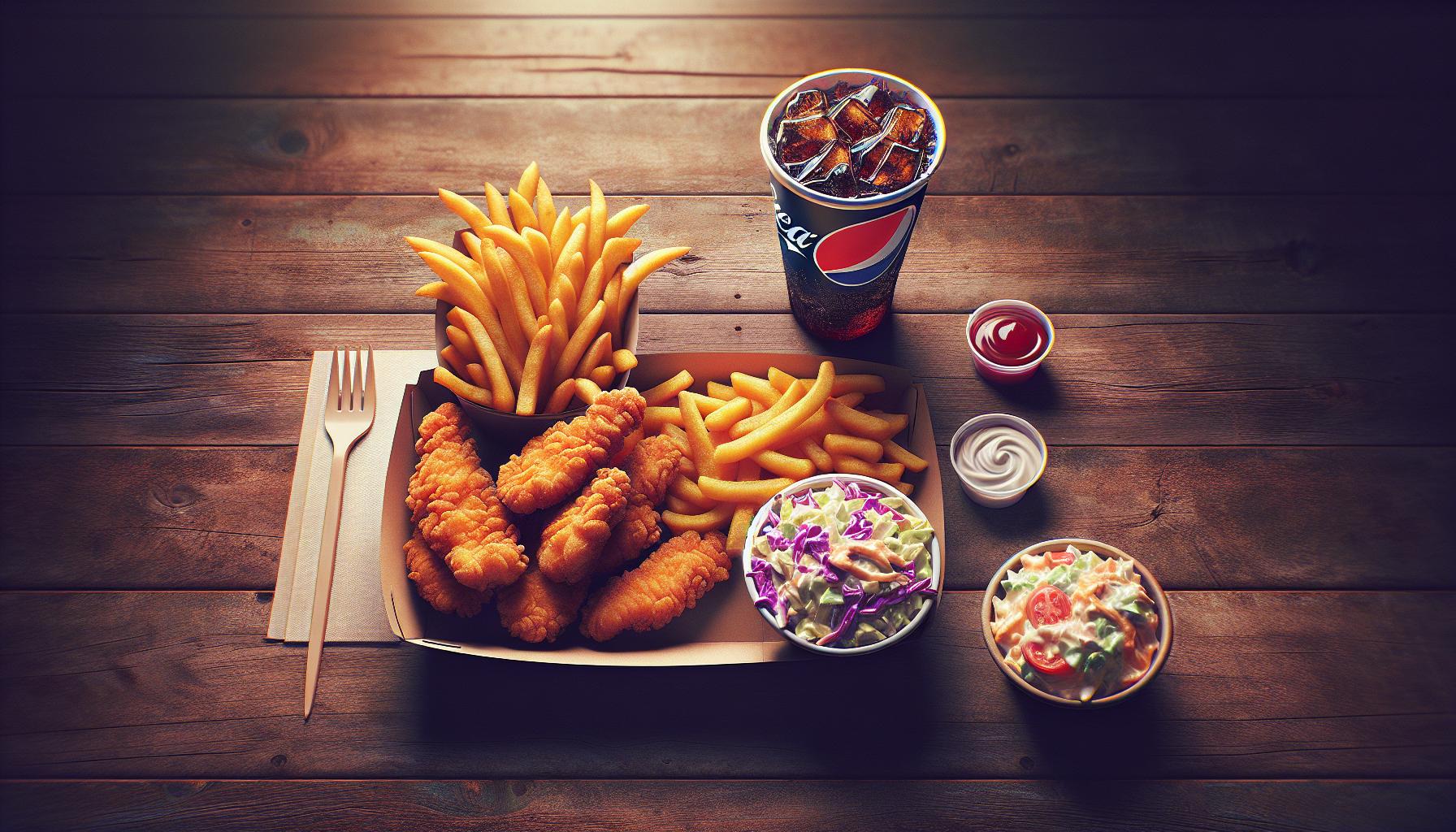When it comes to fast food, Raising Cane’s has carved out a special place in my heart with its mouthwatering chicken fingers and signature sauces. But while indulging in these tasty treats, I’ve often wondered about the nutritional content behind them. Understanding what we’re eating is crucial, whether I’m tracking calories or looking for healthier options.
- Raising Cane’s features a limited menu focused on chicken fingers, fries, coleslaw, and beverages, ensuring transparency in nutritional content.
- The calorie content of menu items can be high; a meal can easily exceed 1,000 calories, emphasizing the importance of portion control.
- Fresh, high-quality ingredients like never-frozen chicken and local produce are prioritized, enhancing both taste and nutrition.
- Awareness of allergens, such as wheat and soy, is crucial for those with dietary restrictions; limited gluten-free options are available.
- Compared to competitors like Chick-fil-A and KFC, Raising Cane’s meals tend to have similar or higher calorie and sodium levels.
- Healthier alternatives exist within the fast food realm; grilled chicken options and salads provide lower-calorie choices for health-conscious diners.
Raising Cane’s Nutrition PDF
Raising Cane’s offers a limited menu focused on chicken finger meals, fries, coleslaw, and drinks. Understanding its nutritional values helps make informed dining choices while enjoying delicious offerings.
Menu Overview
Raising Cane’s specializes in the following items:
- Chicken Fingers: Fresh, hand-breaded chicken fingers served with a variety of dipping sauces.
- Fries: Crinkle-cut fries, seasoned for flavor.
- Coleslaw: A side of coleslaw provides a refreshing crunch.
- Drinks: Options include soft drinks, lemonade, and tea.
The simplicity of the menu allows for a straightforward approach to meals, but it’s crucial to consider the nutritional impact of each item.
Nutritional Values
Here’s a breakdown of key nutritional components for common menu items:
| Item | Calories | Total Fat (g) | Saturated Fat (g) | Sodium (mg) | Protein (g) |
|---|---|---|---|---|---|
| Chicken Sandwich | 650 | 25 | 5 | 1,090 | 28 |
| 3 Chicken Fingers | 750 | 34 | 5 | 1,470 | 37 |
| Large Fries | 410 | 20 | 2 | 350 | 5 |
| Regular Coleslaw | 180 | 14 | 2 | 220 | 2 |
| Soft Drink (16 oz) | 150 | 0 | 0 | 60 | 0 |
Nutritional values reflect standard serving sizes. Eating in moderation is essential for maintaining a balanced diet, especially when indulging in favorites like Raising Cane’s Nutrition PDF chicken fingers and fries.
Analyzing Raising Cane’s Ingredients

Understanding the ingredients in Raising Cane’s Nutrition PDF menu items clarifies nutritional content and aids in making informed choices. Examining key components and their quality reveals important insights into each dish.
Key Ingredients Used
- Chicken: Raising Cane’s uses fresh, never frozen chicken tenderloins, ensuring high-quality protein.
- Batter: The chicken gets coated with a proprietary seasoning blend that enhances flavor and provides a crispy texture.
- Fries: They fry fresh-cut potatoes, seasoned with just the right amount of salt for added taste.
- Coleslaw: The slaw consists of shredded cabbage, carrots, and a creamy dressing, contributing fiber alongside fresh vegetables.
- Sauces: Raising Cane’s sauces, particularly the signature sauce, use a blend of mayonnaise, ketchup, and spices, offering unique flavor profiles.
- Beverages: Soft drinks and iced tea serve as complementary options, providing variety without overwhelming nutritional impact.
Quality of Ingredients
Raising Cane’s emphasizes high-quality ingredients across its menu. The commitment to fresh chicken promotes better taste and nutritional value. Sourcing local produce for coleslaw ensures freshness and supports regional agricultural efforts. The use of trans-fat-free cooking oils for frying contributes to a healthier dish without sacrificing flavor. In addition, ingredients in their sauces contain no artificial preservatives, aligning with modern consumer preferences for clean labels.
By focusing on quality ingredients, Raising Cane’s maintains a straightforward yet appealing menu, allowing customers to enjoy their meals with confidence in what they consume.
Health Considerations

Understanding the nutritional aspects of Raising Cane’s menu items offers insights into making informed dining choices. While the food is delicious, it’s essential to consider its health implications.
Caloric Content
Raising Cane’s menu items vary in caloric content, influencing overall dietary intake. For instance, a pair of chicken fingers contains approximately 300 calories, while the regular fries add another 300 calories. A complete meal, including chicken fingers, fries, coleslaw, and a beverage, easily exceeds 1,000 calories. Tracking these values helps maintain energy balance and prevents excessive calorie intake.
Allergens and Dietary Restrictions
Awareness of allergens is crucial, especially for those with dietary restrictions. Raising Cane’s menu often includes common allergens such as wheat, soy, and egg, found in the chicken batter and sauces. Gluten-free options are limited, as most items are breaded. It’s advisable to consult menu information carefully and inform staff of any allergies when ordering, ensuring a safe dining experience.
Comparisons with Other Fast Food Chains

Raising Cane’s stands out in the fast food landscape, but comparing its nutrition with other chains helps understand its place in the market. Here are some insights into how Raising Cane’s nutritional content measures up against its competitors.
Nutritional Comparisons
When analyzing the nutritional content of Raising Cane’s menu items, several fast food chains offer similar products, making direct comparisons vital. For instance, a meal consisting of chicken fingers, fries, and coleslaw averages over 1,000 calories. In contrast, a comparable meal at Chick-fil-A, such as their chicken nuggets with fries, typically ranges from 700 to 900 calories, depending on portion sizes and dipping sauces.
Additionally, fast food chains like KFC also serve fried chicken. A meal with two pieces of original recipe chicken, a side of mashed potatoes with gravy, and a biscuit can reach over 1,200 calories. Sodium content is another significant factor; Raising Cane’s chicken fingers contain about 1,200 mg of sodium per combo meal, similar to many fried options from other chains like Popeyes.
| Fast Food Chain | Average Calories (Combo Meal) | Sodium Content (mg) |
|---|---|---|
| Raising Cane’s | 1,000+ | 1,200 |
| Chick-fil-A | 700-900 | 1,200 |
| KFC | 1,200+ | 1,400+ |
| Popeyes | 1,100+ | 1,500+ |
Healthier Alternatives
Opting for healthier choices exists even within the realm of fast food. For those who enjoy fried chicken but wish to lower calorie intake, grilled options at Chick-fil-A provide a satisfying alternative. Their grilled chicken sandwich, for example, typically contains around 400 calories and lower fat content.
Another choice includes the “naked” chicken option at Zaxby’s, which reduces breading and calories significantly. Salads at various chains often yield lower calorie counts, with Chick-fil-A’s Market Salad offering around 400 calories and a host of vegetables.
These options show that even in the fast food sector, healthier alternatives exist. Understanding these comparisons helps navigate menu choices responsibly while still enjoying sought-after flavors.
Delicious Fast Food
Raising Cane’s offers a delicious fast food experience that many of us love. However it’s essential to stay mindful of the nutritional content when indulging in these tasty meals. By understanding the calorie counts and ingredient quality I can make more informed choices that align with my dietary goals.
Whether I choose to enjoy a meal occasionally or more frequently moderation remains crucial. With a little awareness I can savor my favorite chicken fingers while also prioritizing my health. So the next time I visit Raising Cane’s I’ll remember to balance enjoyment with nutritional considerations for a satisfying dining experience.

